A Happy Vegetable Garden in Desert Climate
Tips for starting new vegetable garden or for more success in an existing one
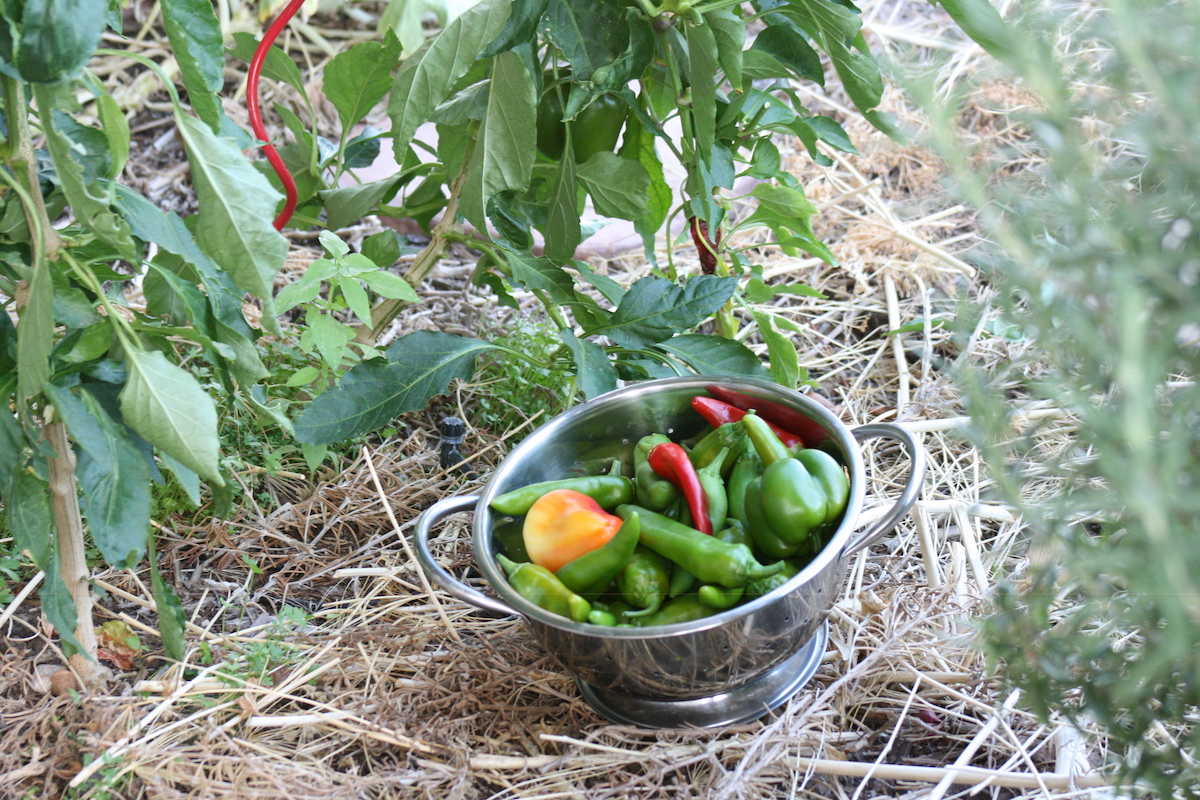
Curiosity to learn and motivation to grow food in our own gardens, is what we need to get started. As we keep on gardening, growing food becomes a routine part of life. Learning and observing the ecosystem of our own garden is essential to successful gardening. Gaining knowledge about growing in desert climate is equally important. All this happens gradually along with the growth of the garden.
Here are some tips for happy gardening.
Here are some tips for happy gardening.
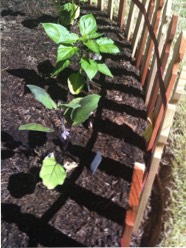
1. Prepare the garden bed in winter (or 1-2 months ahead of planting).
From outside it may seem like a quick project to dig a small bed, add soil amendments and add some plants to that bed. However, the life that flourishes in the soil is what will bring the health to the plants. Soil is full of macro and micro organisms, all working together. It is this soil life that makes it easier for plants to get their nutrients from soil. It is this life underground that gives them strength to fight disease and predators. And that life takes time to develop.
So yes a small bed can be prepared in a few hours but it is best to start it now, a couple of months before you plant the veggies. This will give few months for soil life to grow, ahead of spring (or any other planting season).
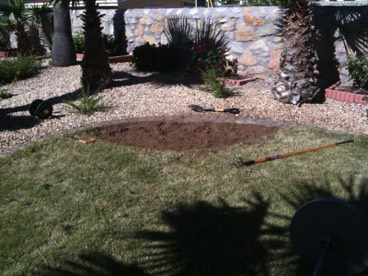
If you have any area on your land without concrete then that is all what is needed. With some creativity you can grow a few plants in a very small area.
Even if you have large area, with lawn or gravel landscaping, just start with a small area. As plants have not been growing in this area for years it will require a lot more organic matter to get started.
If it is all concrete, such as in apartments with only a balcony or patio, then growing in containers is a good option (see below)
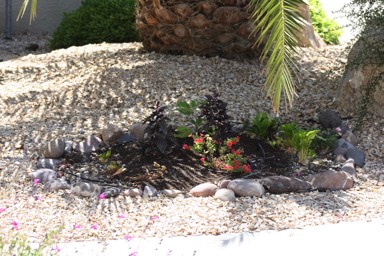
Containers
Start with 2-3 containers only. Without an automatic drip irrigation or other container watering methods, plants may require daily attention. Only herbs should be tried in small containers. For larger plants, depending on the mature plant size, you may need 5-20 gallon size containers for healthy growth.
Start with 2-3 containers only. Without an automatic drip irrigation or other container watering methods, plants may require daily attention. Only herbs should be tried in small containers. For larger plants, depending on the mature plant size, you may need 5-20 gallon size containers for healthy growth.
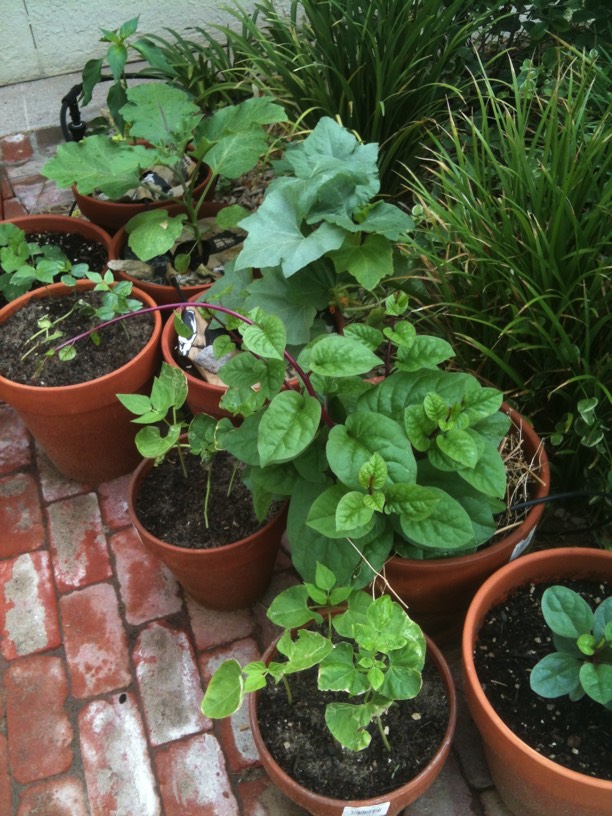
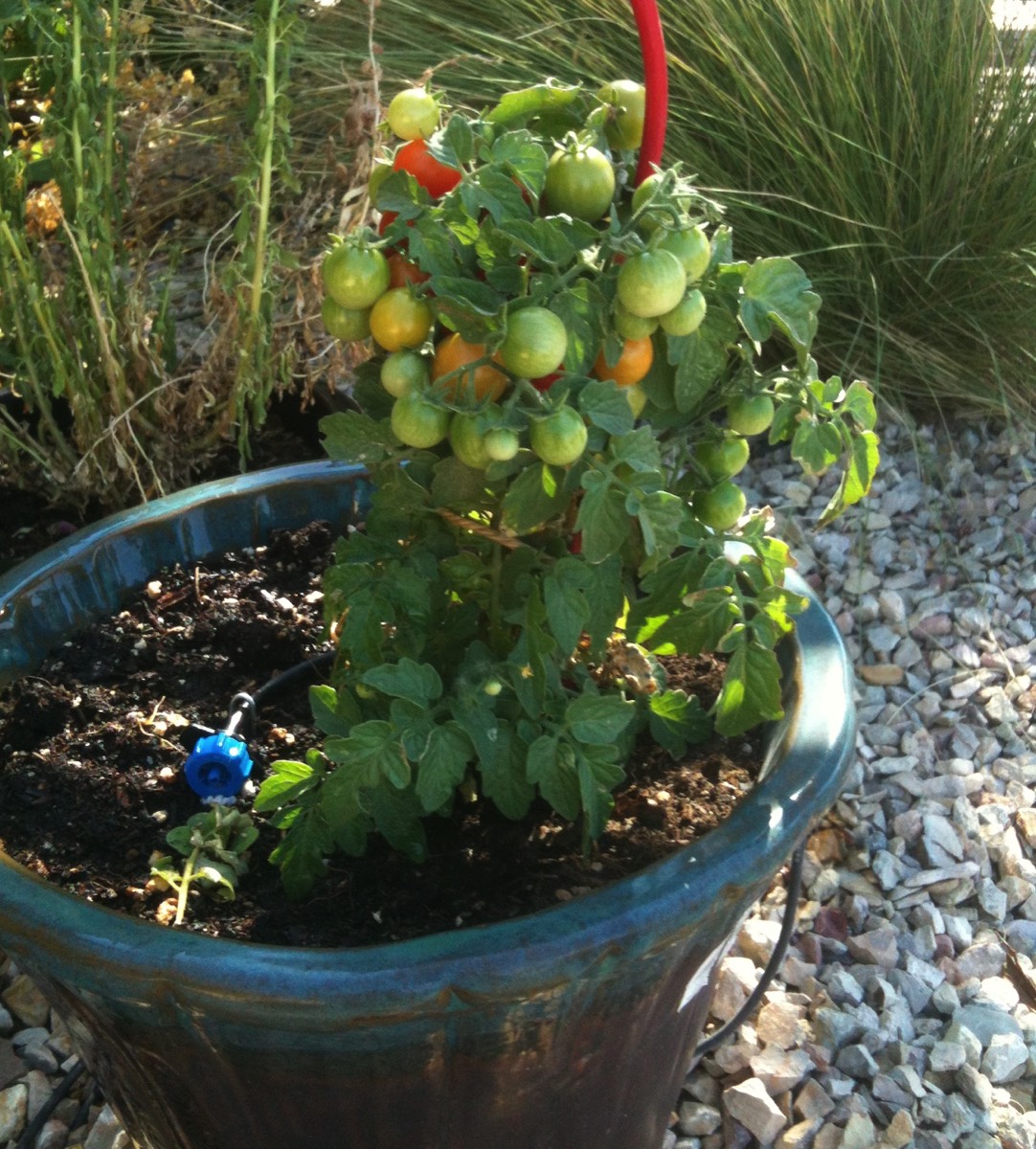
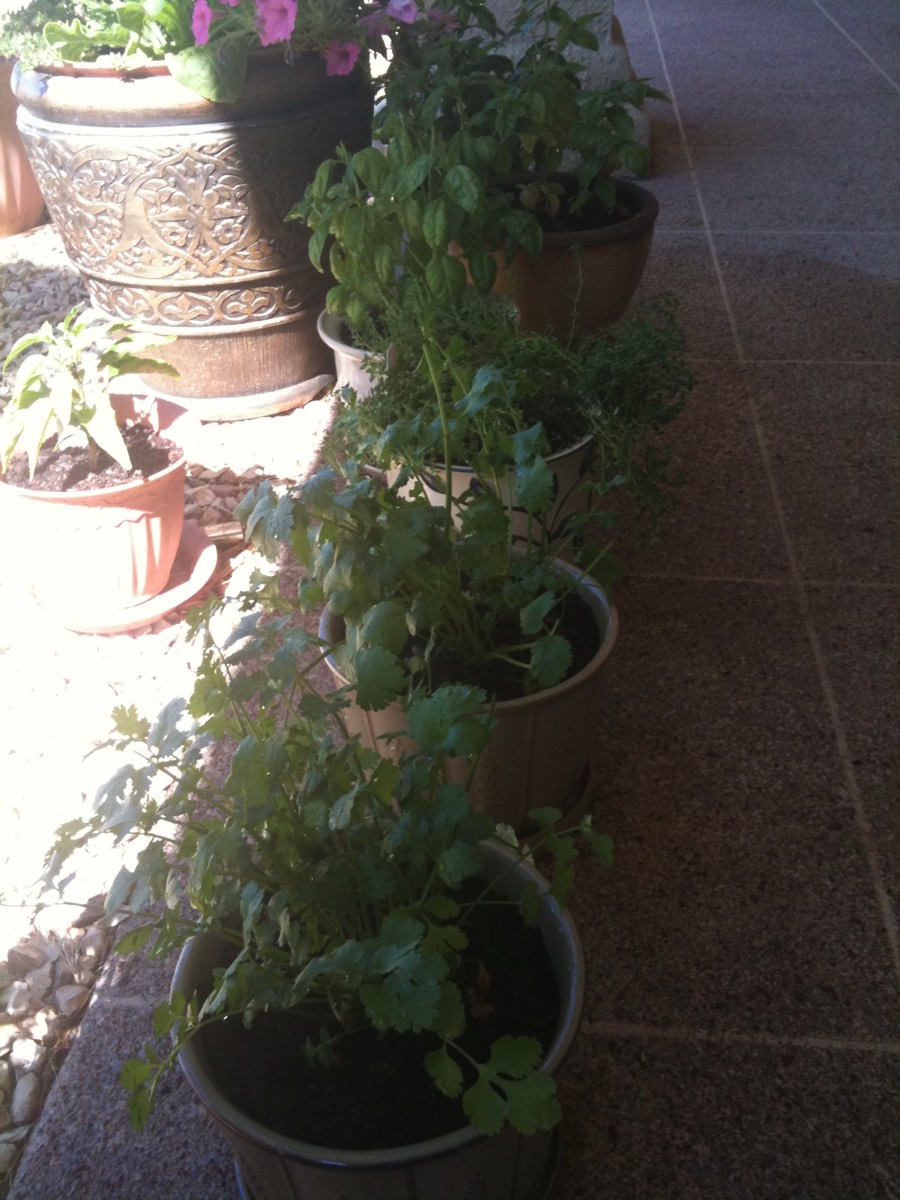
Raised bed, ground level bed or sunken bed
If your ground is very rocky or caliche or has poor drainage due to any reason then a raised bed will be best.
If the soil is clay then any kind of bed might work. However, in a ground level or sunken bed cut down on the watering as needed. Advantage of clay in a desert climate is that less water will be required. Disadvantage is compact soil and or occasional drainage issues (if watered too much, or during rain).
To improve a clay soil keep adding plenty of organic matter to loosen the soil overtime.
Builders sand - In many residential neighborhood, the yard has only builders sand. When a wild area is cleared for development of a new neighborhood, often builders sand may be added to level the ground.
Organic matter is the best way to improve this ground overtime. Adding some top soil initially will also be helpful as the sand drains very quickly and requires more water to keep the soil moist.
However replenishing the bed with organic matter, regularly is a must for any healthy garden soil
If your ground is very rocky or caliche or has poor drainage due to any reason then a raised bed will be best.
If the soil is clay then any kind of bed might work. However, in a ground level or sunken bed cut down on the watering as needed. Advantage of clay in a desert climate is that less water will be required. Disadvantage is compact soil and or occasional drainage issues (if watered too much, or during rain).
To improve a clay soil keep adding plenty of organic matter to loosen the soil overtime.
Builders sand - In many residential neighborhood, the yard has only builders sand. When a wild area is cleared for development of a new neighborhood, often builders sand may be added to level the ground.
Organic matter is the best way to improve this ground overtime. Adding some top soil initially will also be helpful as the sand drains very quickly and requires more water to keep the soil moist.
However replenishing the bed with organic matter, regularly is a must for any healthy garden soil
Continue to help the life in the soil
1) Once the bed is ready and the plants have been started, avoid digging anymore. No till gardening is a term frequently used for this strategy. Dig a hole only to put in the new plant during the next season but avoid digging any other area around it.
2) Add compost on a regular basis
3) Avoid walking or stepping on the planting area. Stepping or walking on the bed makes the soil compact. If it is a large area or wide bed then stepping stones may be added. Step and walk only on these stepping stones when doing garden maintenance.
4) Avoid using any chemical fertilizers. Chemical fertilizers may give instant results but are success is short lasting and not good for longterm health of the soil life and plants.
1) Once the bed is ready and the plants have been started, avoid digging anymore. No till gardening is a term frequently used for this strategy. Dig a hole only to put in the new plant during the next season but avoid digging any other area around it.
2) Add compost on a regular basis
3) Avoid walking or stepping on the planting area. Stepping or walking on the bed makes the soil compact. If it is a large area or wide bed then stepping stones may be added. Step and walk only on these stepping stones when doing garden maintenance.
4) Avoid using any chemical fertilizers. Chemical fertilizers may give instant results but are success is short lasting and not good for longterm health of the soil life and plants.
Automatic irrigation
Whether it is the city water or from rain water tanks, automatic irrigation makes a big difference in the health of home gardens in our desert climate. Even if you are very disciplined about hand watering regularly, automatic irrigation gives you the freedom to travel or take a break if you're tired or ill. Also, the time spent in watering can be spent in other gardening tasks.
Easiest way - Dig your garden bed near an irrigation hose for the existing landscaping in the yard. Add 1/4" tubings to that hose and it will be on the existing timer.
Watering frequency and amount depend on :
Soil type
Plant varieties and type
Use of mulch
Location of the plant bed ( sheltered by buildings or other trees, etc)
Sun and wind exposure in the plant bed location.
Weather and season
Whether it is the city water or from rain water tanks, automatic irrigation makes a big difference in the health of home gardens in our desert climate. Even if you are very disciplined about hand watering regularly, automatic irrigation gives you the freedom to travel or take a break if you're tired or ill. Also, the time spent in watering can be spent in other gardening tasks.
Easiest way - Dig your garden bed near an irrigation hose for the existing landscaping in the yard. Add 1/4" tubings to that hose and it will be on the existing timer.
Watering frequency and amount depend on :
Soil type
Plant varieties and type
Use of mulch
Location of the plant bed ( sheltered by buildings or other trees, etc)
Sun and wind exposure in the plant bed location.
Weather and season
Not enough time for gardening
Gardening may seem intimidating and may seem like a lot of work. A small size residential garden can flourish in good health if you spend just 10 minutes daily for routine checking, harvesting, maintaining. Automatic irrigation is a must for reducing daily maintenance.
It is hard work initially when you prepare the plant bed first time. After that some extra work is required once every 2-3 months or every season change.
Daily maintenance is not absolute requirement for gardening. But a regular gardening habit (daily, weekly, or even monthly) is a good thing for both our health and that of the garden.
As the garden matures over the years, and natural gardening methods are practiced (without chemicals), it requires less and less daily maintenance.
Gardening may seem intimidating and may seem like a lot of work. A small size residential garden can flourish in good health if you spend just 10 minutes daily for routine checking, harvesting, maintaining. Automatic irrigation is a must for reducing daily maintenance.
It is hard work initially when you prepare the plant bed first time. After that some extra work is required once every 2-3 months or every season change.
Daily maintenance is not absolute requirement for gardening. But a regular gardening habit (daily, weekly, or even monthly) is a good thing for both our health and that of the garden.
As the garden matures over the years, and natural gardening methods are practiced (without chemicals), it requires less and less daily maintenance.
Patience and acceptance is what we have to grow, in ourselves, when growing a garden.
Frustrations and disappointments are common but so are the excitements and encouragements. Garden is alive, constantly changing and evolving just like all life.
Observing and letting the process play out naturally might not seem like a practical thing when we are trying to get everything right. But the truth is that garden grows best when we try not to control each and everything. This way we also enjoy the process a whole lot more.
Frustrations and disappointments are common but so are the excitements and encouragements. Garden is alive, constantly changing and evolving just like all life.
Observing and letting the process play out naturally might not seem like a practical thing when we are trying to get everything right. But the truth is that garden grows best when we try not to control each and everything. This way we also enjoy the process a whole lot more.